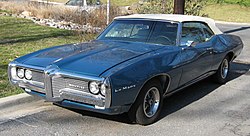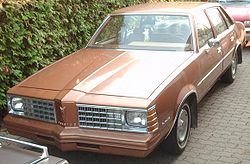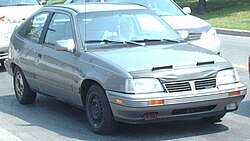Pontiac LeMans
| Pontiac LeMans | |
|---|---|
 | |
| Overview | |
| Manufacturer | General Motors (1962-1981) Daewoo Motors (1988-1993) |
| Production | 1962—1981 1989—1993 |
| Body and chassis | |
| Class | Mid-size (1962—1981) Subcompact (1988—1993) |
| Chronology | |
| Successor | Pontiac Bonneville (For 1982) |
- See also 24 Hours of Le Mans for the race at Le Mans, France
The Pontiac LeMans was a model name applied to compact and intermediate-sized automobiles offered by the Pontiac division of General Motors from 1962 to 1981. The LeMans was replaced by the downsized Pontiac Bonneville for the 1982 model year.
1961-1963
| 1961-1963 | |
|---|---|
| Overview | |
| Production | 1961-1963 |
| Body and chassis | |
| Body style | 2-door coupe 2-door convertible |
| Layout | FR layout |
| Platform | Y-body |
| Powertrain | |
| Engine | 326 in³ V8 |
Introduced as the top-of-the-line version of the compact Pontiac Tempest at the end of 1961 on GM's new Y body platform, the Tempest LeMans was essentially a trim package featuring sportier and more luxurious trimmings than the Tempest, including different badging and bucket seats. That year the name was only used on a two-door pillared coupe. In 1962, LeMans continued on this path, adding a convertible to the offerings. Though all four body styles -- coupe, sedan, convertible and station wagon -- were available as Tempests, there was no four-sedan or station wagon LeMans. There was also no pillarless hardtop version of either Pontiac. The next year, in 1963, the LeMans name was still only used on coupes and convertibles, but the name was officially made its own model. This would last for just one year. It's these 1963 cars of both nameplates that had the high-performance 326 in³ V8 option (actually 336 ci for that one year only) and specially modified versions of them became the Super Duty cars of racing lore.
1964-1969
| 1964-1969 | |
|---|---|
| Overview | |
| Production | 1964-1969 |
| Body and chassis | |
| Body style | 2-door coupe 4-door sedan 4-door station wagon 2-door sedan |
| Layout | FR layout |
| Platform | A-body |
| Powertrain | |
| Engine | 326 in³ 250 hp V8 215 in³ I6 389 in³ V8 230 in³ 265 hp I6 326 in³ 285 hp V8 350 in³ V8 |
| Transmission | 3-speed manual |
The Tempest line was upsized fromto an intermediate-sized car on the new GM A platform in 1964, and the LeMans returned to its role of Tempest trim upgrade with a new 215 in³ six-cylinder and a redesigned 326 in³ V8 (now actually 326 in³). Shortly after the start of the 1964 model year, the LeMans became available with a new performance package designated as the GTO, or Gran Turismo Omologato. The GTO option was priced at just under US$300 and included a larger 389 in³ V8 from the full-sized Pontiac line that put out 325 or 348 hp, a three-speed floor shift manual transmission with Hurst shifter, heavy-duty suspension, red-line Tiger Paw tires, and GTO nameplates. GTO sales ended up at 32,000 for the first year, well beyond initial estimates of 5,000 units and accounted for a large share of Tempest/LeMans sales. The success and the image of the GTO helped increase sales of lesser Tempest and LeMans models in the coming years, placing the Pontiac brand into third place in total industry sales after Chevrolet and Ford.
The GTO became a separate model of its own for 1966, though retaining the same basic body as the Tempest and LeMans models. For 1966, all Pontiac intermediates got swoopier styling featuring tunnelback rooflines on two door hardtop and pillared coupes. While the GTO continued as a big-engined muscle car, the Tempest and LeMans models got a new SOHC 230 in³ six-cylinder engine as the base engine. The new SOHC I6, the brainchild of Pontiac Chief Engineer John De Lorean (who became Pontiac's general manager in 1965), was available in an economical one-barrel carbureted, 165 hp version that was standard equipment on all Pontiac intermediates except GTOs. Optional on all Tempest and LeMans models except station wagons was a Sprint package that included a hopped-up four-barrel version of the 230 in³ OHC six that also included higher compression ratio and hotter cam, along with a floor-mounted three-speed transmission with Hurst shifter, suspension kit, and body striping. Those who preferred a V8 engine could get either the base two-barrel 326 in³ V8 rated at 250 hp (the most popular Tempest/LeMans engine) or a 285 hp four-barrel 326 HO V8 with higher compression ratio, high performance cam and dual exhausts.
The Sprint-optioned Tempest and LeMans models were not very popular during the mid-to-late 1960s as they were greatly outsold by the bigger-engined GTO that was heating up the muscle car wars. Buyers of regular Tempest and LeMans models definitely preferred V8 power, as the 326 and later 350 in³ V8s were the most ordered engines. The Sprint option and SOHC six-cylinder engine were discontinued after 1969 with an ordinary Chevrolet-built 250 in³ OHV six-cylinder engine, becoming the base engine from 1970 to 1976 in most Pontiac intermediates.
Initially, the LeMans included a pillared coupe and convertible for 1962 and 1963 as no hardtops were offered in the compact Tempest. For 1964, a hardtop coupe was added followed by a four-door pillared sedan in 1965, which was replaced by a four-door hardtop in 1966 and a four-door Safari wagon in 1968. Generally, the four-door and wagon models were differentiated from the coupes and convertibles by featuring conventional bench seats or notch-back bench seats with folding armrests as opposed to the Strato buckets seats standard in coupes and convertibles. Other LeMans upgrades over lesser Tempests included carpeted lower door panels, deluxe steering wheels, courtesy lighting, and full wheel covers.
1970-1972
| 1970-1972 | |
|---|---|
| 1972 Pontiac LeMans Safari wagon | |
| Overview | |
| Production | 1970-1972 |
| Body and chassis | |
| Body style | 2-door coupe 4-door sedan 4-door station wagon 2-door sedan |
| Layout | FR layout |
| Platform | A-body |
| Powertrain | |
| Engine | 400 in³ 265 hp V8 |
For 1970, Pontiac reshuffled its intermediate lineup a bit with the LeMans nameplate downgraded to the mid-line sub-series previously known as the Tempest Custom and included two and four-door pillared sedans, while the previous top-shelf LeMans series was renamed the LeMans Sport in the same three body styles including a four-door hardtop sedan, two-door hardtop coupe and convertible. This year, bigger engines - which had previously reserved for GTOs - were made available on lesser Tempest/LeMans models including a 400 in³ V8 rated at 265 hp with a two-barrel carburetor or a 330 hp option with a four-barrel carburetor and dual exhausts.
In 1971, the Tempest nameplate was completely retired and Pontiac promoted the LeMans nameplate to full-series status to identify all of its intermediate models, which still included the GTO. At the bottom of the line was the Pontiac T-37, previously known as the Tempest.
For 1972, all Pontiac intermediates were now LeMans models as the GTO was downgraded from a sub-series to an option package and the low-priced T-37 line was replaced by a stripped LeMans pillared coupe. The top-line intermediate was the Luxury LeMans, available in hardtop sedan and coupe models, featuring plusher interiors than regular LeMans models. The LeMans Sport was available as a two-door hardtop or convertible featuring Strato bucket seats and plush interior fittings from the Luxury LeMans.
1973-1977
| 1973-1977 | |
|---|---|
| Overview | |
| Production | 1973-1977 |
| Body and chassis | |
| Body style | 2-door coupe 4-door sedan 4-door station wagon |
| Layout | FR layout |
| Platform | A-body |
From 1973 to 1977, the LeMans and other GM intermediates were much larger in size than previous models due to evolutionary changes that resulted in larger cars year after year and federally-mandated 5 mph crash bumpers that added weight and length. During this period, Pontiac's intermediate lineup included the base LeMans, LeMans Sport Coupe, GTO (1973 only), Luxury LeMans (became the Grand LeMans in 1975) and the Euro-style Grand Am. Body styles were all based on GM's Colonnade hardtop design for both sedans and coupes (no convertibles offered after 1972) that included center pillars for improved rollover safety standards but eliminated true hardtop design, along with frameless windows similar to a hardtop.
1978-1981
| 1978-1981 | |
|---|---|
 | |
| Overview | |
| Production | 1978-1981 |
| Assembly | Sainte-Thérèse, Quebec, Canada |
| Body and chassis | |
| Body style | 2-door coupe 4-door sedan 4-door station wagon |
| Layout | FR layout |
| Platform | A-body |
| Powertrain | |
| Engine | 231 in³ Buick V6 265 in³ Pontiac V8 301 in³ Pontiac V8 305 in³ Chevrolet V8 (Calif.) 350 in³ Oldsmobile diesel V8 |
| Transmission | 3-speed THM200 automatic 4-speed THM200-4R automatic |
| Dimensions | |
| Wheelbase | 108 in |
In 1978, the LeMans and other GM mid-sized cars were considerably downsized and lost some 600-800 lb in the process, as part of GM's corporate downsizing program to reduce the size and weight of its automobiles in the aftermath of the Arab Oil Embargo induced energy crisis of 1973 to 1974. Engines were downsized as well with engine options reduced to a standard Buick-built 231 in³ V6 or an optional Pontiac-built 301 in³ V8 for 1978 (some 1978s, the Grand LeMans for sure, were available with the GM small block 5 liter 305 in³ motor), compared to larger 350, 400 and 455 in³ V8s offered in previous years. From 1978 to 1980, Pontiac's mid-sized lineup included the base LeMans, Grand LeMans and a revived Grand Am that was much more suited in size and concept as a Euro-style sport sedan than the larger 1973 to 1975 models. The Grand Am in this guise was not a tremendous seller as a sedan or coupe. Only a coupe was offered in 1980 before that nameplate was discontinued and mothballed for a few years before the Grand Am name was revived again for 1985 as a new compact car, the form which the Grand Am would take for the next two decades until it was replaced by the Pontiac G6 in 2005. The final year for the mid-sized LeMans was 1981, with only the base and Grand LeMans models offered initially and joined at mid-year by a new LJ trim level positioned between the base and Grand models. The car was given a new slanted nose which made it popular in NASCAR, especially as a superspeedway race car. Engine offerings by this time included Buick's 231 in³ V6, Pontiac's 4.3 L 265 in³ V8, Pontiac's 301 in³ V8, Chevrolet's 305 in³ V8 (for California only) and Oldsmobile's 350 in³ diesel V8.
For 1982, Pontiac dropped the LeMans nameplate for its mid-size car, rebadging it as the Bonneville, which had denoted the division's top-line full-sized cars for many years until the division discontinued all of its big cars after 1981. The LeMans-cum-Bonneville was reduced to one trim line in four-door and Safari wagon models and offered no Pontiac engines as the division discontinued V8 production after 1981 to concentrated on Iron Duke four-cylinder engines for GM's smaller cars. The engine lineup now consisted of the Buick V6 or Chevrolet 305 V8, along with the Olds 350 diesel. The mid-sized Bonneville wagon was dropped after 1983 while the sedan lingered until 1986. For 1987, the Bonneville nameplate was moved to a slightly larger front-wheel drive full-sized sedan that shared its basic platform with the Buick LeSabre and Oldsmobile Delta 88.
1988-1993
| Pontiac LeMans | |
|---|---|
 | |
| Overview | |
| Also called | Passport Optima (1989-1991) Asuna SE (1993 Sedan) Asuna GT (1993 Hatchback) |
| Production | 1989-1993 |
| Assembly | Bupyong, South Korea |
| Body and chassis | |
| Body style | 3-door hatchback 4-door sedan |
| Layout | FF layout |
| Platform | T-body |
| Related | Opel Kadett |
| Powertrain | |
| Engine | 1.6L 74 hp I4 2.0L I4 |
| Transmission | 4-speed manual (base) 5-speed manual (LE, SE, GSE) 3-speed automatic (LE, SE, GSE) |
| Dimensions | |
| Wheelbase | 99.2 in |
| Length | 1992-93 Sedan: 176.9 in 1992-93 Hatchback: 167.9 in 1989-1991 Hatchback: 163.7 in 1989-1991 Sedan: 172.4 in |
| Width | Hatchback: 65.5 in Sedan: 65.7 in |
| Height | Hatchback: 53.5 in Sedan: 53.7 in |
The LeMans was marketed as a rebadged version of the Opel Kadett and was built by Daewoo of South Korea between 1989 and 1993. It was a replacement for Pontiac's T1000 and Acadian (in Canada) models. In Canada, this LeMans was known as the Passport Optima from 1989-1991 and the Asuna SE (sedan)/GT (hatchback) for 1993.
Initially, the LeMans was available as a 3-door 'Aerocoupe' hatchback and a 4-door sedan. In 1989 more models were released including a sportier LeMans GSE based on the Opel Kadett GSi 16V, with a 96hp 2.0 liter 4-cylinder engine. The GSE was available in a monochromatic paint scheme in red, white or silver with 14" alloy wheels, fog lights and a rear spoiler. The GSE also had the Recaro-style seats of the European Opel Kadett. A LeMans SE sedan with upgraded equipment from the base and LE models also had the 96hp 2.0 liter 4-cylinder engine (also used in the Chevrolet Cavalier and Pontiac Sunbird.
While on paper a good design, poor quality hurt sales and the LeMans and Asuna SE/GT were discontinued after 1993 with no replacement. Also, the Asuna brand was discontinued that year.
Pontiac LeMans in popular culture
- In the movie The French Connection, Gene Hackman drives a 1970 LeMans during the famous chase scene.
- In the movie Smokey and the Bandit, Jackie Gleason's character, Sheriff Buford T. Justice, drives a 1977 Pontiac LeMans.
- In the 1968 film Night of the Living Dead, the opening shots of the movie shows a 1967 Pontiac LeMans being driven to a cemetery. Then during the famous cemetery scene of the movie the lead actress flees in the car, in which a few moments later wrecks into a tree.
External links
- The A-Body Site covers 1973-1977 Pontiac LeMans, GTO, Grand Am, Luxury LeMans, Grand LeMans, LeMans sport coupe
